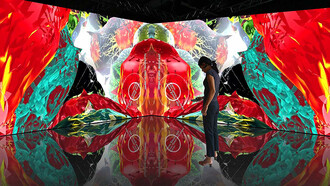We all know that commerce is the main drive of all art fairs, yet the commodity of being able to view the hard work of hundreds of galleries and artists in one day is something of an experience, not only to the collector, but to everyone with an interest in the contemporary. Artissima is definitely the art fair to see innovative and exciting new artist, yet discover fantastic works from established artists from the past. Seeing an entire booth dedicated to the 70’s work of Valie Export, in the “Back to the Future" section of the Charim Galerie, is by itself worth a visit to the fair. Her provocative works on the role of the woman in society have inspired a whole generation of younger artists. The same can be said by the P420 gallery booth entirely dedicated to the Italian conceptual artist Franco Vaccari, who is finally receiving the attention he deserves, after being the first, in the sixties and seventies, to introduce the concept of “exhibition in real time”, an exhibition that is being created by the spectators by their presence. Probably his most well known example for this kind of work was his “photomatic” booth at the Venice Biennale of 1972, where visitors were asked to “leave a trace” by taking a snapshot of themselves in the photo cabinet, then stick it on the wall of the gallery. The result is an astounding array of shots documenting the expression and fashion of people in a sort of proto-Facebook in black and white.
Artissima confirms itself as a very conceptual art fair, so visitors may be surprised by the little visuals they encounter in some booth. Words and projects often replace canvases and sculptures, and this means you need to take your time to read and understand each project in order to fully experience some works. This can be tricky (and boring at times) but often in can be the key to really enter the realm of vision of the world of each artists. “Present Future”, the curatorial section of the fair, sees the work of 20 young artists who have the opportunity of showing their recent work with a whole booth - making it probably the most interesting section of the fair. Notable the installations of Meris Angioletti, Santo Tolone and Jenny Perlin.
Visitors were also struck by the political work of Croatian Nemanja Cvijanović, who showed a huge European flag sporting a swastika instead of the usual circle of stars, and an annoying sound installation made by the voices of the collectors who bought their right to shout at passersby: “this is a private property!” Overall Turin, with its fair and an outstanding number of satellites and other events, confirms to be one of the three top spots of Italian contemporary art.















